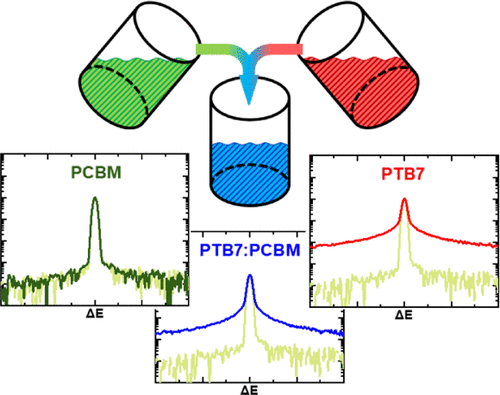当前位置:
X-MOL 学术
›
ACS Appl. Polym. Mater.
›
论文详情
Our official English website, www.x-mol.net, welcomes your
feedback! (Note: you will need to create a separate account there.)
Investigation of Molecular Dynamics of a PTB7:PCBM Polymer Blend with Quasi-Elastic Neutron Scattering
ACS Applied Polymer Materials ( IF 4.4 ) Pub Date : 2020-08-03 , DOI: 10.1021/acsapm.0c00455 Dominik Schwaiger 1 , Wiebke Lohstroh 2 , Peter Müller-Buschbaum 1, 2
ACS Applied Polymer Materials ( IF 4.4 ) Pub Date : 2020-08-03 , DOI: 10.1021/acsapm.0c00455 Dominik Schwaiger 1 , Wiebke Lohstroh 2 , Peter Müller-Buschbaum 1, 2
Affiliation

|
In organic photovoltaics, bulk heterojunctions (BHJs) of organic semiconductor substances such as conjugated polymers and fullerenes are frequently used as active layers in which light is transformed into free charge carriers. The performance of the respective solar cells is critically influenced by the inner morphology of the active layer. Besides structural, also dynamical properties are important but by far less frequently investigated. In this study, we probe the polymer dynamics of an active layer composed of a low band gap polymer and a fullerene derivate. The acceptor [6,6]-phenyl-C61-butyric-acid-methyl-ester (PCBM) and the donor poly[[4,8-bis[(2-ethylhexyl)oxy]benzo[1,2-b:4,5-b′]dithiophene-2,6-diyl][3-fluoro-2-[(2-ethylhexyl)carbonyl]thieno[3,4-b]thiophenediyl]] (PTB7), as well as their 1:1 blend, are probed with time-of-flight quasi-elastic neutron scattering. Our observable timescale window of motions covers a range from 1 ps to approximately 50 ps. We probe a temperature range from 150 to 400 K, which covers the reported maximum power conversion efficiency of the respective BHJ solar cells. Within this temperature range, PCBM does not show any dynamics on the observable timescale. Blending with PCBM (wt. ratio 1:1) causes frustration of the PTB7 side-chain dynamics, which manifests in increased relaxation times and decreased diffusion coefficients. Important for solar cell applications, temperature variations do have a major impact on the polymer dynamics, which in some circumstances are far more pronounced than the influence of blending with PCBM. Furthermore, we show that this temperature dependence follows an Arrhenius-type behavior.
中文翻译:

具有准弹性中子散射的PTB7:PCBM聚合物共混物的分子动力学研究
在有机光伏中,有机半导体物质(例如共轭聚合物和富勒烯)的本体异质结(BHJ)经常用作活性层,其中光被转换成自由电荷载流子。各个太阳能电池的性能受到活性层内部形态的严重影响。除了结构之外,动力学特性也很重要,但到目前为止研究的频率很少。在这项研究中,我们探讨了由低带隙聚合物和富勒烯衍生物组成的活性层的聚合物动力学。受体[6,6]-苯基-C 61丁酸甲酯(PCBM)和施主聚[[4,8-双[(2-乙基己基)氧基]苯并[1,2- b ] : 4,5 - b ']二噻吩-2,6-二基] [3-氟-2-[(2-乙基己基)羰基]噻吩并[3,4-b[噻吩二基]](PTB7)以及它们的1:1混合物,用飞行时间准弹性中子散射进行探测。我们可观察到的时间刻度运动窗口范围从1 ps到大约50 ps。我们探测的温度范围为150至400 K,该温度范围涵盖了各个BHJ太阳能电池的报告的最大功率转换效率。在此温度范围内,PCBM在可观察的时间范围内没有显示任何动态。与PCBM(重量比1:1)混合会导致PTB7侧链动力学受挫,这表现为弛豫时间增加和扩散系数降低。对于太阳能电池应用很重要,温度变化确实会对聚合物动力学产生重大影响,在某些情况下,这种变化远比与PCBM共混的影响更为明显。此外,
更新日期:2020-09-11
中文翻译:

具有准弹性中子散射的PTB7:PCBM聚合物共混物的分子动力学研究
在有机光伏中,有机半导体物质(例如共轭聚合物和富勒烯)的本体异质结(BHJ)经常用作活性层,其中光被转换成自由电荷载流子。各个太阳能电池的性能受到活性层内部形态的严重影响。除了结构之外,动力学特性也很重要,但到目前为止研究的频率很少。在这项研究中,我们探讨了由低带隙聚合物和富勒烯衍生物组成的活性层的聚合物动力学。受体[6,6]-苯基-C 61丁酸甲酯(PCBM)和施主聚[[4,8-双[(2-乙基己基)氧基]苯并[1,2- b ] : 4,5 - b ']二噻吩-2,6-二基] [3-氟-2-[(2-乙基己基)羰基]噻吩并[3,4-b[噻吩二基]](PTB7)以及它们的1:1混合物,用飞行时间准弹性中子散射进行探测。我们可观察到的时间刻度运动窗口范围从1 ps到大约50 ps。我们探测的温度范围为150至400 K,该温度范围涵盖了各个BHJ太阳能电池的报告的最大功率转换效率。在此温度范围内,PCBM在可观察的时间范围内没有显示任何动态。与PCBM(重量比1:1)混合会导致PTB7侧链动力学受挫,这表现为弛豫时间增加和扩散系数降低。对于太阳能电池应用很重要,温度变化确实会对聚合物动力学产生重大影响,在某些情况下,这种变化远比与PCBM共混的影响更为明显。此外,











































 京公网安备 11010802027423号
京公网安备 11010802027423号